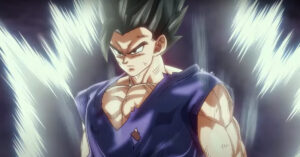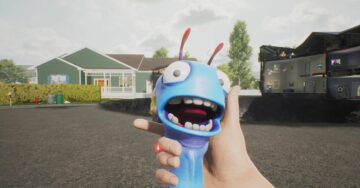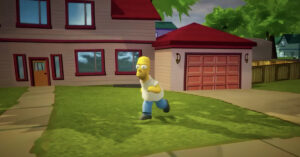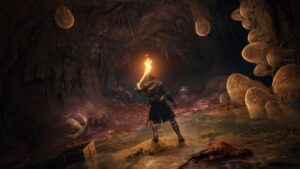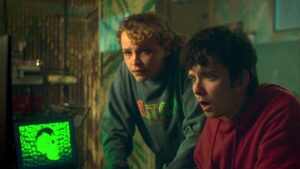A dystopian sci-fi series about an easily transmittable illness that disproportionately affects adults and thrusts our reality into chaos hits close to home in 2021. Anna, the latest streaming gamble AMC Plus acquired internationally, starts off strong with the uncanny timeliness of that instigating event. The mysterious disease manifests in red bruises and wounds, and it kills everyone once they reach puberty. The surviving children organize themselves into roaming gangs that peruse and pillage, united in the fear of what will eventually happen to them when they come of age as well.
It’s a plot out of the original-series Star Trek episode “Miri,” but without the same momentum. Between the jarringly split timeline, the sparse development of its central character, and the series’ inconsistency regarding how fantastical it wants to be, Anna grabs viewers early, then loses that grip.
Author Niccolò Ammaniti adapted his own 2015 novel Anna, set in 2020, for the miniseries. He’d been filming for six months when the COVID-19 pandemic broke out. Giving authors control of adapting their own material into a new medium can go a couple of ways, and Stephen King’s involvement in his recent TV adaptations is a useful example. When an author returns to established characters, crafting new arcs and endings to underline their work, they have a chance to emphasize themes and ideas that were already in the text. A story might gain additional resonance in a different form, like the well-cast recent version of King’s The Stand did. Alternately, an author revisiting their work might emphasize the flaws, tediousness, and self-absorption that were also already there, which happened with King’s messy adaptation of Lisey’s Story. It’s a real touch-and-go proposition that can end in creative triumph or catastrophe. Anna ends up with a little of both.
Anna takes place in Italy, where 13-year-old Anna (the steely Giulia Dragotto) takes care of her younger brother Astor (Alessandro Pecorella) in a remote section of woods, with a perimeter marked by barbed wire and rags. The Red Virus pandemic has made the world an increasingly unhinged, empty place. Anna warns Astor of monsters, ghosts, and gigantic birds in an effort to keep him safe and give him the childhood she never had. “The outside’s all black. They’re all dead, Astor. You and me are alive because the woods protect us,” Anna says. While he stays in their shelter, Anna searches surrounding neighborhoods, churches, and stores for food.
Danger is everywhere, both internally — if Anna begins menstruating, her life is literally over — and externally, in the form of twins Mario (Danilo Di Vita) and Paolo (Dario Di Vita), who take to cruelty easily and enthusiastically. Bully Angelica (Clara Tramontano) adds to the peril, as a miniature tyrant who runs a cult of practically cannibalistic children. And even friendly Pietro (Giovanni Mavilla) is a problem, when his light flirtation with Anna distracts her from the responsibilities of caring for Astor. Anna splits its time between the threats of the present day and recurring flashbacks to Anna and Astor’s memories of their mother Maria (Elena Lietti), who wrote them a journal of instructions about how to care for each other and stay safe in a world without adults as she was dying.
That division of attention allows for some context and contrast in showing how a seemingly well-functioning society collapsed so quickly and thoroughly. The flashbacks leave a trail of breadcrumbs: Anna’s parents arguing about how to care for her as infection rates rise, news coverage about the spread of the disease, overhead snatches of conspiracy-theory sharing. (Think of Cittàgazze in Philip Pullman’s His Dark Materials series.)
But that approach also means that each episode struggles to find forward rhythm, and often stalls out when it comes to connecting child Anna and preteen Anna. Viviana Mocciaro (as the younger Anna) and Dragotto do have similarly admonishing glares, but the miniseries waits too long to explore their shared personality traits, and portray how the former grew into the latter. Although young Anna is a presence in the series from the beginning, the finale episode is the first time we see at length how she cared for Astor in their parents’ absence. That material would have provided a more foundational sense of Anna if provided earlier, and without it, the elder version of the character feels somewhat slight. With that vacuum left at the show’s center, what instead stands out are the most garish aspects of each episode.

Children can be monstrous to each other, and Anna luxuriates in the possibilities of savagery caused by growing up too soon. Episode after episode offers up new villains to face off against Anna, as the threat of the Red Virus looms. Children cheat, chase, and abuse each other. The trio of little girls dressed as Disney princesses, who are also gleefully in charge of torturing Anna, are particularly enraging. Anna being caged and led around on a collar and leash is difficult to watch. Angelica keeping a hostage nude and in chains, then speaking casually about burning someone alive and eating their ashes, works because of how coolly Tramontano plays the character’s nearly sociopathic self-absorption. Anna swings for the fences by careening from one ghastly development to another, and although the series initially seems to have a Hook by way of The Lord of the Flies duality, it gets real dark, real quick.
But at a certain point, so much wildness seems like a cover for a plot that feels stretched over six episodes. For book readers, the series’ abandonment of certain characters, its tweaking of various motivations, and its different ending might feel like a betrayal of the source material’s messages about forgiveness, violence, and survival. The extremely changed tenor of the series’ final scene completely shifts the novel’s originally bleak conclusion, and the novel’s ambiguity might have been a stronger way to end.
It certainly fits in better with the source material’s overall fascination with the illusory nature of happiness, and warnings about avoiding the cruelties of an unsentimental reality. But other changes in Anna open up new narrative doors. The choice to unfurl the backstory of one supporting character per episode provides portraits of the myriad ways people responded, either selfishly or humanistically, to the Red Fever. There is more than a whiff of exploitation and even fetishization in a subplot involving a character who in the Before might have been judged and rejected for their physicality, but Roberta Mattei’s thoughtful, vulnerable performance is worth watching.
A sort of loophole in how the mysterious Red Fever disease spreads sets up an intriguing path forward. And visually, so much of the unpredictability and nastiness of Anna comes to life in the series’ thrilling chase scenes through abandoned churches, overgrown plazas, and crumbling bridges; in the demanding chants and desperate cries of feral children; and in the rituals of decoration and adornment that the children turn to stave off adulthood.
Ammaniti, who also directed all six episodes, has an eye for lavish decrepitude and an understanding of how to build tension on screen. A 2D animated sequence of hulking monsters stalking through a field to hover over a lonely boy intriguingly mixes mediums, bringing to life the thickly scribbled, all-black illustrations of the fantastical beings that Anna describes to Astor as formidable foes.
During each episode, Anna skips between extremes in lighting and color, from the pitch-black inside of a boarded-up store turned into a dungeon to the riotous explosion of rainbow-hued fabrics hanging between the walls of a palatial mansion. The series’ willingness to embrace surreal, grotesque, and marvelous images does somewhat make up for repetitive scripts and perpetual sidelining of the protagonist. But by the end of the series, those latter elements matter more than the visual interest found in a bedazzled human skull, a pile of rocks atop a grave, or the inky midnight blue of a vat of paint used to signify children’s allegiances.
In Anna’s second-half stretch of episodes, in which Anna and Astor’s bond is tested and it becomes clear that neither older sister nor younger brother is exactly well-defined enough for their separation to resonate, the shortcomings of the series’ visuals-over-characterization approach becomes clear. Anna is often entrancing in its Return to Oz aesthetic, but looking for more than surface style here might be as improbable as a cure for the Red Fever.
Anna premiered on AMC Plus on Nov. 18, with new episodes streaming every Thursday.
Source: https://www.polygon.com/reviews/22790185/anna-review-amc
- 2020
- Abandonment
- adapting
- Additional
- aesthetic
- All
- Ambiguity
- animated
- anna
- around
- authors
- Black
- Breadcrumbs
- build
- care
- caused
- charge
- chase
- child
- Children
- Conclusion
- content
- Couple
- COVID-19
- COVID-19 pandemic
- Creative
- cure
- day
- dead
- Development
- DID
- Disease
- Disney
- Duality
- Early
- ends
- Event
- eye
- Face
- Fever
- Filming
- First
- first time
- flaws
- food
- form
- Forward
- Giving
- Growing
- here
- Home
- How
- How To
- HTTPS
- human
- illness
- infection
- interest
- IT
- Italy
- keeping
- Kills
- latest
- Lavish
- Led
- light
- Long
- mansion
- materials
- medium
- Momentum
- months
- mother
- news
- Offers
- open
- Other
- paint
- pandemic
- parents
- People
- performance
- Personality
- Personality Traits
- Plus
- Polygon
- present
- protagonist
- protect
- Rates
- readers
- Reality
- returns
- rise
- safe
- Screen
- sense
- Series
- set
- shared
- Shelter
- SIX
- So
- Society
- split
- spread
- Star Trek
- stay
- store
- stores
- streaming
- Surface
- text
- The
- The Source
- the world
- threats
- time
- tv
- United
- us
- Vacuum
- viewers
- virus
- Vulnerable
- Watch
- What
- WHO
- Wire
- Work
- works
- world
- worth
- youtube
